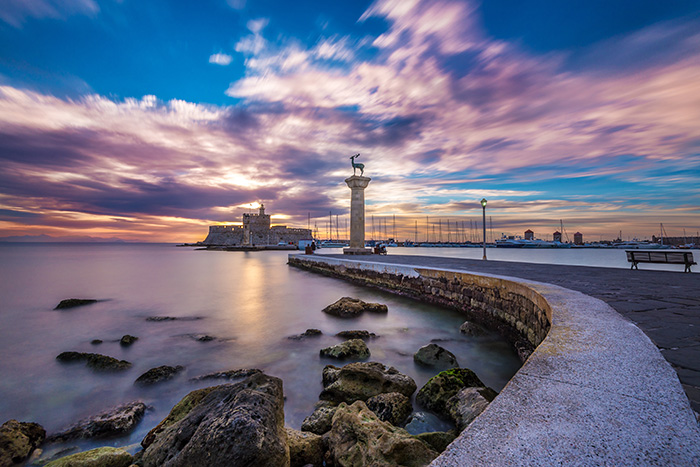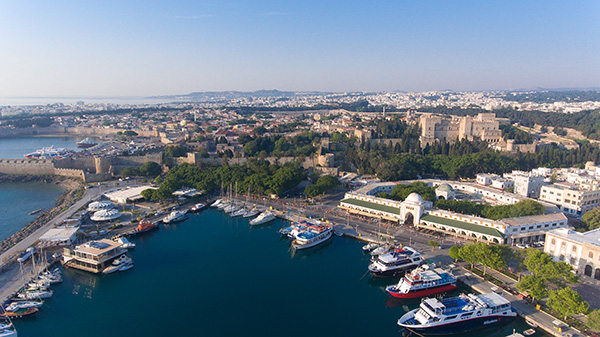Introduction
 Rhodes, an emerald isle of unparalleled natural beauty. Τhe largest island of the Dodecanese complex in Greece, the fourth after Crete, Evia and Lesvos (Lesbos). Known as the island of the gods Sun and Apollo, the island of the Knights, after the Knights of Saint John of Jerusalem. A crossway between nations and civilizations, where Aegean meets Middle East. Hosted the mythical Colossus of Rhodes, one of the Seven Wonders of the Ancient World, while the Medieval Old Town is listed as a UNESCO World Heritage site.
Rhodes, an emerald isle of unparalleled natural beauty. Τhe largest island of the Dodecanese complex in Greece, the fourth after Crete, Evia and Lesvos (Lesbos). Known as the island of the gods Sun and Apollo, the island of the Knights, after the Knights of Saint John of Jerusalem. A crossway between nations and civilizations, where Aegean meets Middle East. Hosted the mythical Colossus of Rhodes, one of the Seven Wonders of the Ancient World, while the Medieval Old Town is listed as a UNESCO World Heritage site.
Distinguished for its rich natural environment, beautiful beaches and modern tourist facilities, elements that have for decades made it a one of the most popular tourist destinations both nationally and worldwide. The archaeological sites, the mediaeval monuments and the cosmopolitan resorts arranged in the traditional style make Rhodes a popular destination hard to resist even to a demanding traveler.
History
 Rhodes carries with it 5000 years of history. During ancient times it has been habitated by several ethnic groups: Telkhines, Carians, Phoenicians and Dorians. Τhe latter built the three major cities of Lindos, Kamiros and Ialyssos, which united to establish the city of Rhodes at 408 Β.C. The three centuries to follow have been the golden age of Rhodes.
Rhodes carries with it 5000 years of history. During ancient times it has been habitated by several ethnic groups: Telkhines, Carians, Phoenicians and Dorians. Τhe latter built the three major cities of Lindos, Kamiros and Ialyssos, which united to establish the city of Rhodes at 408 Β.C. The three centuries to follow have been the golden age of Rhodes.
The island was a center of economic and cultural exchanges among people for many centuries. Its strategic position yielded it with wealth and made the city of Rhodes one of the most pre – eminent cities of Ancient Greece. The marine trade, the navigation know – how and the wisely progressive political and diplomatic management helped to conserve the city powerful. The science and the arts have flourished for centuries in Rhodes.
The homeland of many Olympic champions and philosophers. Diagoras was one the greatest athletes ever lived, having been victorious twice at the ancient Olympic Games, while Leonidas was the most famous Olympic runner in the ancient world. For four consecutive Olympiads (164–152 BCE), he was the champion of three-foot races, the Stadion (200 meters), the Diaulos (400 meters), and the Hoplitodromos (400-meter race performed with bronze armor and shield). He held a 2000-year record for winning 12 gold medals in 3 different events. Andronicos of Rhodes was the scholarch (head) of the Peripatetic school. He is most famous for publishing a new edition of the works of Aristotle that forms the basis of the texts that survive today.
Text references and excavations prove the glory of Rhodes and its Greek identity, which was reserved during the centuries, despite the various invasions by Romans, Knights of St John, Ottomans and Italians, until its union, in 1948, with its motherland Greece. The Turkish occupation was the darkest period in its history. Greek inhabitants of the city were forced to leave the walled Town and settle outside it, forming new suburbs which they called ‘marasia’. During the foreign occupation many towns – and especially Lindos – were able to flourish thanks to their stock and production in foodstuffs, clothing, silverware, household utensils and perfumes. After the defeat of the Axis powers, Rhodes and the other Dodecanese islands came under British military administration until March 7th 1948, when the Greek flag was finally raised over the Governor’s Palace.
Attractions
At any site of Rhodes visitors meet monuments reflecting the history of 50 centuries. Every corner is a trip to the past, to different civilizations and religions that sealed them.
Among monuments worth mentioning is:
- The Acropolis of the city of Rhodes, with its ancient stadium and theater at the top of the Monte Smith Hill
- The Acropolis of Lindos and the village settlement
- Ancient Kamiros
- Mt Philerimos with the basilica church dedicated to the Virgin Mary, built over an ancient temple
- The island’s castles at Monolithos, Kritinia, Asklepio, Archangelos and Charaki
- The numerous newer buildings, architectural monuments left behind by the Italians, that include the impressive Kallithea.
Don’t omit to visit the Butterfly Valley, the Seven Springs and Kallithea with its thermal springs and, of course, the beautiful beaches of the island.
Religious sites of Rhodes give the visitor the opportunity to discover its universal dimension and meet another aspect of its history. Visitors can admire magnificent temples of the early-Christian era, Byzantine churches with elaborate carved wooden altarpieces and religious icons, famous monasteries and many chapels.
You can visit, among others, Panagia Tsambika, Panagia Church at Kremasti, the Monastery of Panagia Skiadeni (Virgin Mary the “Shade Casting”), The Our Lady of The Castle. Worth visiting are also the two Roman Catholic churches of Rhodes, San Francisco and Santa Maria, as well as the Muslim mosques and Synagogues at the Old Town.
Medieval Town
 One of the most beautiful medieval towns of Mediterranean area, declared by UNESCO, since 1988, World Cultural Heritage Site. A mosaic from different historical eras, with these of Knights and of the Ottomans being dominant.
One of the most beautiful medieval towns of Mediterranean area, declared by UNESCO, since 1988, World Cultural Heritage Site. A mosaic from different historical eras, with these of Knights and of the Ottomans being dominant.
The Knights of the Order of St John from Jerusalem arrived in Rhodes at 1310 A.D. Since then, the Medieval Town has been enriched with gothic and renaissance elements. The whole set of palaces, towers, churches, arcs and cobble paves fascinates every visitor. Grand Master’s Palace (Kastello) distinguishes as a great monument from the Knight era. Nowadays, important exhibitions have been hosted in its halls. Archaeological Museum is housed in the gothic building of the big knight’s hospital and its halls bear masterpiece articrafts of Rhodian art, findings from ancient Kamiros and Ialyssos and mosaic floors from the town.
The Knights Street, that magnificent street leading to the Grand Master’s Palace, hosts the restored lodgings of the Langues (Tongues) of the Order. Other locations in the Medieval Town worth visiting are the Church of Our Lady of The Castle, the Clock Tower, the Kahal Kadosh Shalom Synagogue and the Suleymaniye and Recep Pasha Mosques.
The Medieval Old Town of Rhodes i
Modern Town
 The past and present, such as castles, neoclassical buildings and Italian architecture, are uniquely combined at the city of Rhodes. Italian buildings dominate the seafront of the city of Rhodes, a modern cosmopolitan city.
The past and present, such as castles, neoclassical buildings and Italian architecture, are uniquely combined at the city of Rhodes. Italian buildings dominate the seafront of the city of Rhodes, a modern cosmopolitan city.
In the historic center stand out the Rodon Hotel, the buildings of Italian architecture which today house the Town Hall, the Prefecture and the Post Office, the Church of Annunciation, the National Theater and, of course, the small fawn statues which are trademarks of Rhodes.
Enjoy a walk at the Mandraki Marina with the small yachts, as well as the settlements and neighborhoods just outside the city center, the so – called Marasia.
Following the coastal road, it will take you to the Aquarium of Rhodes, the most important scientific center for the study of marine life in Greece.
You can also browse the Municipal Gallery, the second largest gallery in Greece, after the one in Athens, and also the Gallery of Modern Art “Nestoridion Melathron” at Gabriel Haritos Square (Ekato Hourmadies).
Nature

Rhodes is a blessed place, endowed by nature itself with beautiful coasts, several kilometers long, with a rich aquatic environment and a unique variety of plants and animals in its mainland. It has abundance of waters, a diverse landscape and favorable climatic conditions.
All over the island there are sites of outstanding natural beauty:
- NATURA 2000 protected areas
- The world-famous Butterfly Valley, a rare habitat
- The Seven Springs with the century’s old sycamore trees and the crystal-clear waters
- The forests of Prophetis Elias and Kymisala, the bushes of Mt Attaviros, Prasonisi, the dunes of Apollakia Bay, the torrents of Loutanis and Gadouras and the Posidonia sea grass (seaweed).
This natural environment is home to the famous miniature horse of Rhodes, Bonelli’s eagle, the Dama Dama dear, the peacock of Rhodes, while rare species of shrubs and plants thriving such as peonies and orchids, fifty species of which are endemic only in Rhodes.
In the rivers and streams of the island lives the fish Ladigesocypris ghigii or simply gizani, while in its clean seas and coasts lives the Monachus Monachus seal and the Caretta Caretta sea turtle.
Rhodes is world famous for its amazing, vast and award-winning beaches. At the east, stand out the beaches of Tsambika, Charaki and Stegna, the beach of Afantou next to the Golf, and Kallithea.
At the south, the most popular beaches are the beaches of Kiotari, Glystra, and Pefki and in the southern part of the island there is Prasonisi, popular spot for windsurfers. Worth visiting is also the beaches at St Pavlos in Lindos as well the one in Gennadi with its dunes and its bushy wild – cedars.
Gastronomy
 Delicious meat, fresh fish and seafood-based dishes, as well as a wide variety of desserts made with cereals, olive oil, nuts, fruits, honey and herbs, compose the uniqueness of Rhodes’ cuisine.
Delicious meat, fresh fish and seafood-based dishes, as well as a wide variety of desserts made with cereals, olive oil, nuts, fruits, honey and herbs, compose the uniqueness of Rhodes’ cuisine.
Both in traditional taverns and international cuisine restaurants the flavors of Rhodes, the local tastes and dishes and appetizers figure prominently. The ones that stand out are: Rhodes bagel, giapraki (stuff vine leaf), rifaki or kapamas (stuffed goat), karavolous (escargots), milla or sparingia (asparagus) and pitaroudia (fried chickpea balls), all processed with local Rhodian products and accompanied by wheat bread and Rhodian wine. In the vineyards, in the mountainous regions of the island, they grow rare grape varieties with guaranteed designation of origin such as “Athiri” or “Amorghiano”.
As for desserts, visitors can taste a wide variety of local products. From the famous Rhodian melekouni with sesame, almonds and honey, which is given at weddings and baptisms, talagoutes and spoon sweets, to diples (dough stuffed with cinnamon and sesame) and katimeria (traditional dough with sugar and cinnamon).
Rhodes has a rich market with modern shopping centers and designer stores offering a large variety of consumer products and luxury items by Greek and foreign brands.
Geography
The island of Rhodes is oblong and has the shape of a spear edge. Located about 460 kilometers southeast of Athens, 380 km west of Cyprus and 18 km southwest of Turkey. Its length is 77 km, width 37 km and total area of 1,401 square kilometers (1,408,749 acres).
It has 253 kilometers of coastline. It can be described as mountainous with the highest mountains the Attavyros (1210 meters), the Artamytis (825 meters) and the Prophet Ilias (800 meters).
Just like all of Greece, Rhodes’ climate is Mediterranean. Summers are very hot and dry while the winters relatively mild and very rainy. Temperatures during summer can are about 30-35 degrees Celsius on average, while during heat waves they can reach up to 40 degrees. During the winter, temperatures average 5-10 degrees Celsius, which can go lower depending on winds or heavy rain.
The maximum and minimum temperatures per month are as follows:
Jan | Feb | Mar | Apr | May | Jun | Jul | Aug | Sep | Oct | Nov | Dec | |
o C Min | 10 | 10 | 12 | 15 | 18 | 22 | 27 | 27 | 26 | 22 | 18 | 14 |
o C Max | 13 | 13 | 16 | 20 | 24 | 28 | 32 | 34 | 30 | 27 | 23 | 17 |
For more weather information please click here: www.meteo.gr


